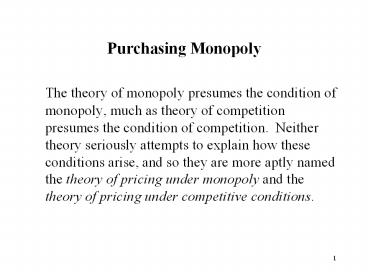Purchasing Monopoly - PowerPoint PPT Presentation
Title:
Purchasing Monopoly
Description:
Purchasing Monopoly The theory of monopoly presumes the condition of monopoly, much as theory of competition presumes the condition of competition. – PowerPoint PPT presentation
Number of Views:79
Avg rating:3.0/5.0
Title: Purchasing Monopoly
1
Purchasing Monopoly
- The theory of monopoly presumes the condition of
monopoly, much as theory of competition presumes
the condition of competition. Neither theory
seriously attempts to explain how these
conditions arise, and so they are more aptly
named the theory of pricing under monopoly and
the theory of pricing under competitive
conditions.
2
- The Profit of Monopolization
- Implicit assumption that monopoly already
exists. Assume that only one entrepreneur seeks
to profit from the conversion of a competitive
industry to a monopoly. - Barriers to entry play no important role so the
task faced by this one monopolizer is not one of
purchasing a legal barrier to competition but of
purchasing the power to set price in the face of
unblockaded entry.
3
(No Transcript)
4
- The profit to monopolization (per period), then,
can be thought to vary between - depending on the payment required to keep
price-reducing capacity in other industries.
The minimum subtraction from standard monopoly
profit is the forgone
competitive rent .
5
- If QEQM can be kept out only by paying owners a
significant fraction of the monopoly rent they
forgo by refraining from entering the monopolized
industry, then the amount that must be subtracted
from standard monopoly profit to calculate the
profit to monopolization is larger. The maximum
subtraction adds the forgone monopoly rent of
potential entrants, , to the amount
that must be subtracted.
6
- The Propensity to Monopoly
- The tendency to monopoly is thus a function of
the difference between the rents to monopoly and
to competition. Ceteris paribus, the more
inelastic the market demand, the greater is the
monopoly rent, and the more elastic is the
supply, the smaller is the competitive rent. - Figure 10.2 shows the intersection of D at the
right angled kink of yields a positive
monopoly rent in combination with a zero
competitive rent.
7
(No Transcript)
8
(No Transcript)
9
- A reasonable pattern of acquisition prices
requires the monopolizer to pay more to acquire
competitive assets the closer he is to completing
the monopolization of the industry. - At the very beginning of the acquisition
process, the probability of successful
monopolization is close enough to zero that the
price paid for specialized assets should be no
greater than their value under competitive
conditions. At the end of the monopolization
process the price paid should be very close to
the monopoly rent.
10
- The path of capacity acquisition prices might
approximate line PCB in Figure 10.3. The return
to monopolization is then area PCPMDG minus area
AGB. - To the extent that there is rivalry to
monopolize the target industry, the line PCB will
approach line PMB, so that the return to
monopolization is even more likely to be
negative.
11
(No Transcript)
12
- Estimating the Welfare Loss from Monopolization
- In Harberger-type estimates, the deviation in an
industrys profit rate from the average of
manufacturing profit rates, or some such measure,
is used as an index of the deviation of monopoly
price from competitive price. - In Figure 10.4, we use D and PCES to represent
demand and supply for a Harberger study of the
deadweight loss of monopoly.
13
- The deadweight loss triangle is .
Harberger theoretically indexes the size of this
triangle by vertical line AC, with AC empirically
estimated from recorded profit rates. However,
in the present analysis, recorded profit rates
reflect the difference between the vertically and
horizontally shaded areas
- .
- If monopoly is the source of higher recorded
profit rates, the empirical estimate of AC must
understate the real magnitude of AC and,
therefore, of the deadweight loss triangle.
14
- The Risks of monopolization
- A departure from the easy monopolization
assumptions with which we started makes it clear
that attempts to monopolize are fraught with
risks of various kinds. - Some of the risks of monopolization, and some of
the costs of deterring entry, can be offset by
abandoning the purely private approach in favor
of securing government aid. Entry barriers
imposed and policed by the government present a
formidable hurdle to the reentry or new entry of
capacity.































